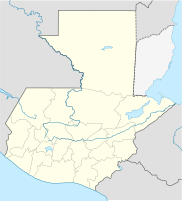San Marcos (Guatemala)
| San Marcos | ||
|---|---|---|
|
Coordinates: 14 ° 58 ′ N , 91 ° 48 ′ W San Marcos on the map of Guatemala
|
||
| Basic data | ||
| Country | Guatemala | |
| Department | San Marcos | |
| Residents | 35,000 | |
| Detailed data | ||
| surface | 121 km 2 | |
| Population density | 289 inhabitants / km 2 | |
| Time zone | UTC −6 | |
| City patron | Mark (Evangelist) | |
| San Marcos | ||
San Marcos is a city in Guatemala and the administrative seat of the Department of San Marcos and the municipality of the same name ( Municipio ), which covers 121 km². Together with the neighboring city of San Pedro Sacatepéquez in the east, San Marcos forms a contiguous settlement area in which around 80,000 people live.
Location and climate
The city is located about 250 km northwest of Guatemala City and 52 km northwest of Quetzaltenango in the highlands of the Sierra Madre at an altitude of 2,398 m. You can reach San Marcos from Guatemala City on the Interamericana (CA 1) and the national road 1, which branches off to the southwest at Cuatro Caminos. San Marcos is located in the Valle de Candacuchex ("cold place") near the 4,220 m high Tajumulco . The climate is temperate to cold.
Economy and tourism
San Marcos and San Pedro are on an old trade route to Mexico . On the one hand, they still benefit economically from through traffic, on the other hand, the proximity of the Mexican-Guatemalan border also creates problems due to drug and people smuggling. San Marcos is a trading center for agricultural products. The city is also known for its textile production.
San Marcos does not offer many tourist attractions. The cemetery and the temple-like building of the city administration ( Palacio Maya ) are worth seeing . The slightly more affluent San Pedro Sacatepéquez is known for its public celebrations during Holy Week ( Semana Santa ). Both places are suitable as a starting point for excursions into the surrounding mountains of the Sierra Madre. There are hot springs at Agua Tibia .
history
In 1533 Juan de León y Cardona subjugated Mam, who lived in the Candacuchex Valley, on behalf of Pedro de Alvarado . Spanish soldiers and Dominicans , together with Mexican mercenaries, founded a small settlement that later belonged to the Corregimiento de Quetzaltenango as El Barrio . At the end of the 18th century, the place was almost completely destroyed by earthquakes . After independence from Spain it belonged together with the whole west to the Estado de Los Altos , the so-called sixth state of the Central American Confederation . A church consecrated to the Evangelist Mark gave its name to San Marcos and finally to the department established in 1866 . At the end of the 19th century, the Guatemalan government tried to end the rivalry between San Marcos and San Pedro Sacatepéquez by amalgamating the city of La Unión by decree . The union only lasted until 1945. The two cities, each of which is the administrative seat of two different Municipios, are separated by a wide avenue . San Marcos became a bishopric in 1950 . The former suburb of San Pedro is now a little larger than San Marcos.

